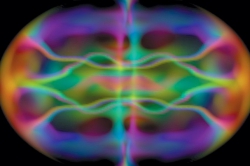Exactly ten years ago, in 2007, the Nobel Prize in Physics was awarded to scientists Peter Grünberg and Albert Fert. In 1988, they discovered the giant magnetoresistive effect (GMR effect), or giant magnetoresistance (GMR). This effect initiated spintronics. Spintronics is a technology of data storage and processing in which information is encoded in the orientation of the spin - the internal momentum of the electron.
Technologies based on the work of Grünberg and Fert are now widely used in computers. Their use has significantly increased the density of information stored on any magnetic media. The use of GMR-effect helps a hard drive's scanning head become very sensitive, even to the smallest variations in the magnetic field. These smallest changes are used to encode the data on a magnetic medium. In the field of experimental physics, this discovery is also widely used: in modern labs it is used to produce spin-polarized electrons the spins of which are oriented in the same direction.
Soon the researchers gained perspective that the basic principles of spintronics can be extended to a whole variety of magnetic structures surrounding us. This led to origination of skyrmionics, the study of exotic magnetic ring formations called "skyrmions". Skyrmions have attracted special attention in the last decade. Researchers are interested in creating compact memory cells with the help of this quasiparticle. Skyrmions’ extremely small size (about 1-2 nanometers), their low power consumption, as well as sufficient stability that makes them viable for practical application - all of these can lead to the creation of ultra-compact storage devices based on them.
Why the skyrmion appeals to scientists
We have to mention that the history of skyrmions started back in 1962. The starting point was the work of British researcher Tony Skyrme, who showed that a special class of nonlinear models in quantum field theory allows a solution in the form of localized excitations. As part of this concept, an attempt was made to describe the properties of protons and neutrons. However, a significant surge of interest in the results obtained then arose only a few decades later. In 1989, Soviet physicist Aleksei Bogdanov predicted in his pioneering work the existence of spin vortex states - skyrmions - in magnetics.

Dmitry Yudin
"He considered a certain class of magnetic materials, the crystal lattice of which does not contain an inversion center. As a result of this, the Dzyaloshinskii-Moriya interaction appears. It turned out that the competition between the Dzyaloshinskii-Moriya interaction, which is antisymmetric, and the standard exchange interaction of Heisenberg, leads to skyrmion formation in ferromagnetic films," - explains Dmitry Yudin, research associate at the Department of Nanophotonics and Metamaterials at ITMO University. - "Thus, a theory developed in one field of physics has been successfully implemented in another."
So, what is a skyrmion? This is a non-trivial magnetic texture that resembles a vortex-like state. A skyrmion has a mysterious property: a magnetic agitation can cause a change in its atomic spin, but does not cancel the spin itself. This property, called topological stability, is common in geometric figures like the Mobius strip, which is created by putting together the two ends of a ribbon after turning one of them over. This semi-turn is considered stable because it can be turned over and will not untie unless one cuts the tape and returns it to its original position.
Skyrmions were first obtained in lab conditions using Lorentz microscopy in 2010. From then on, scientific groups around the world have begun working in this field.
"Why is there such a growing interest in this topic It turns out that the skyrmion can be successfully used in information processing and storage systems. This way, the range of a threshold current needed to move a domain wall in ordinary ferromagnets is several magnitude orders greater than the same range required for a skyrmion. So, we can expect revolutionary changes in skyrmion-based data processing and transfer systems," - Dmitry Yudin continues.

A skyrmion in static and moving states. Credit: nkj.ru
As we know, conventional magnetic carriers – like, for example, the surface of a hard drive – carry information in the form of digital bits, the state of which is identified as "0" or "1", depending on the atom’s magnetization. But, when they are packed too tightly or overheated, this magnetization loses its properties. Skyrmion allows us to store information in a sustained way, based on the same principle of zero and one, depending on whether or not a magnet assembly is there. However, in order to advance further, scientists need to find a way to manage the properties of skyrmions.
Research at ITMO
Physicists from ITMO University have proved in theory that the properties of a skyrmion can be controlled using an external radiation source.
"As part of our research, from a general perspective of microscopic theory, we consider how external linearly polarized electromagnetic radiation affects the properties of magnetic domains in thin ferromagnetic films with strong spin-orbit interaction. It turns out that an external source of radiation can be used as some kind of a tool in order to control the properties of a skyrmion, namely its stability, size and shape. We are assuming that the predicted effects can also be observed in magnetic films using femtosecond laser pulses. We think that the results are fundamentally correct at high temperatures. This makes it possible to create an optically controlled system of skyrmions for possible use in racetrack memory devices," - Dmitry Yudin, one of the scientists behind this study, comments.
In the future, scientists are determined to verify these results empirically. They are planning to complete this research in cooperation with foreign colleagues from the Netherlands - a group of scientists at the University of Nijmegen (Radboud Universiteit Nijmegen) and their collaborators from the Ioffe Physical-Technical Institute of the Russian Academy of Sciences, who are renowned experts in the field of magnetic systems. As Dmitry Yudin points out, in the course of experiments the researchers intend to confirm the possibility of managing skyrmions with the help of an external laser field.

Spintronics. Credit: princeton.edu
Skyrmion-based calculations
Today, such giants of the semiconductor industry as Intel and IBM have taken a keen interest in spintronics and, in particular, in the study of skyrmions. Take Intel, for instance: the company has an entire Research Unit in the city of Hillsboro (Oregon, USA) which carries out research in this field.
As Dmitry Yudin explains, research in the field of skyrmionics can be useful in both improving existing devices and creating fundamentally new platforms.
"Due to the developments in this field in the future, we can offer a different new platform: for example, calculations based on skyrmions. How would that look like? As part of our recent study, we have proven the possibility of creating a skyrmion-based majority element. This kind of system usually requires switch by majority: imagine that we have an odd number of input channels and alongside each channel a signal is being spread (for example, '0' or '1' in binary logic). All these signals converge at one point, where the signals somehow interact with each other. And there is an output channel where we observe what happened after this interaction. This way, for the majority element, the output signal will coincide with '1', if the greater part (more than half) of the incoming signals were '1', or with '0' - if it was otherwise. The design we are offering consists of three input channels. As part of a numerical simulation, it was demonstrated that if there are 2 or 3 skyrmions at the input, we get a skyrmion at the output. In a reverse situation, when initially there is zero or 1 skyrmion in the system, a skyrmion in the output channel will not be produced. And that corresponds fully with the definition of the majority element and can be used for the first experimental demonstrations of logic operations based on skyrmions," - says the scientist.
Yudin then adds that in the next 3 to 5 years we can expect an emergence of non-volatile memory devices based on skyrmions. The first empirical results obtained in this field look promising. In the future, the development of skyrmionics can lead to the creation of a new generation of processors.
Translated by Eugenia Romanova




